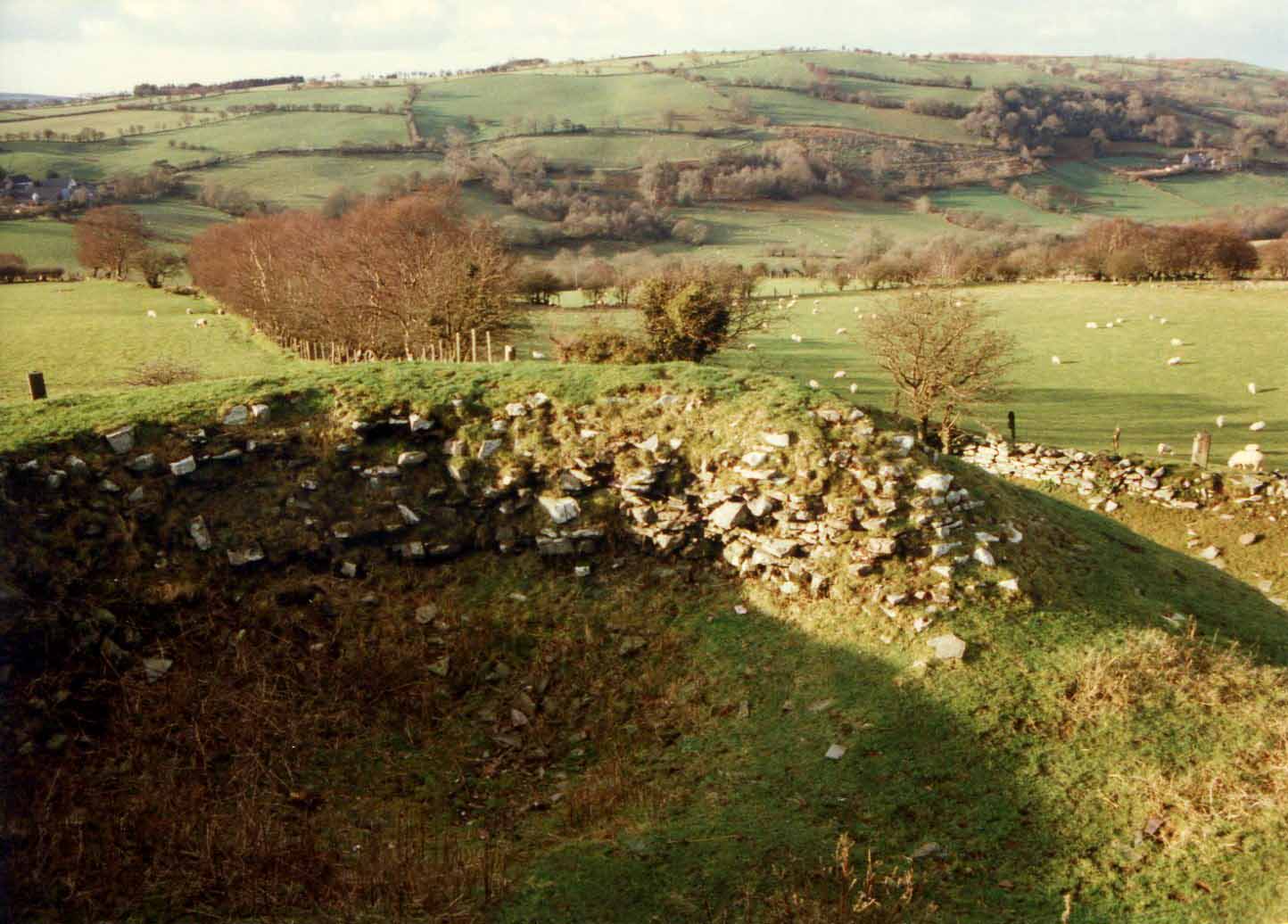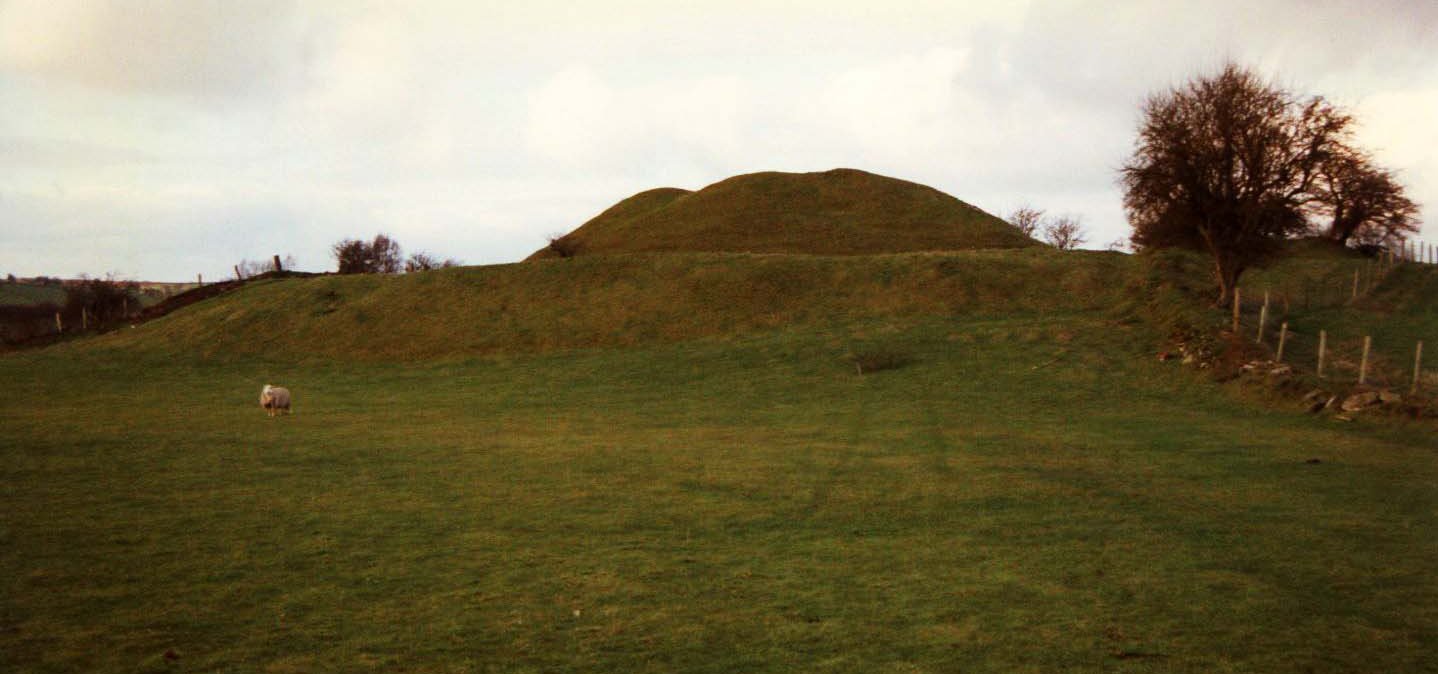Cwm Camlais
Cwm Camlais castle lies well within the old upland zones of the
old Welsh kingdom of Brycheiniog. It stands on a prominent rise
of ground nearly 1,200' above sea level and has no known history,
although it was obviously once a place of some importance. In the
mid fourteenth century a record was made stating that the land round
about had been given to Einion Sais by Earl Humphrey Bohun of Brecon
(1221-1275 or 1265-98) to strengthen the castle of Camlais. This
tells nothing about the castle's provenance assuming that this was the
castle referred to and not Sennybridge castle, under 3 miles away to the north-west.
 Camlais castle may have been built by Prince Llywelyn ap Gruffydd
(d.1282) in his period of predominance in Brycheiniog (1262-76).
As such it might have been the castle recorded as destroyed by the Lord Edward
(d.1307) in 1265. This might explain Earl Humphrey Bohun wanting
it strengthened in the late 1270s. Humphrey had only reconquered
this part of Brycheiniog from Llywelyn in 1276. The present state
of the castle suggests that it is unlikely that Einion did anything to
help preserve the fortress and it is never mentioned again. It
would also seem possible this is the lost castle of Einion Sais of
Penpont, as it stands only one mile from the traditional site in the
Usk valley below.
Camlais castle may have been built by Prince Llywelyn ap Gruffydd
(d.1282) in his period of predominance in Brycheiniog (1262-76).
As such it might have been the castle recorded as destroyed by the Lord Edward
(d.1307) in 1265. This might explain Earl Humphrey Bohun wanting
it strengthened in the late 1270s. Humphrey had only reconquered
this part of Brycheiniog from Llywelyn in 1276. The present state
of the castle suggests that it is unlikely that Einion did anything to
help preserve the fortress and it is never mentioned again. It
would also seem possible this is the lost castle of Einion Sais of
Penpont, as it stands only one mile from the traditional site in the
Usk valley below.
Description
Standing at the top of a rise above the diminutive River Camlais,
Castell Cwm Camlais is an odd fortified site. Often described as
a motte, the remains actually seem to be solely a round tower keep,
some 30' in internal diameter with walls up to 10' thick. The
interior of the tower still boasts a fine rubble ashlar to the south
and in the early 1980s a ground floor doorway was excavated to the
east. This has since been covered up. The tower is
surrounded by a ditch, still 6' deep in places as well as a powerful
counterscarp, but has no obvious bailey. There is a causeway
across the ditch to the south-west. In style it is rather similar
to the Welsh castle of Bodyddon in
Powys which was destroyed in 1257. Such similarities may increase
the likelihood of it being a Welsh built castle.
Why
not join me at other Lost Welsh Castles next Spring?
Please see the information on tours at Scholarly
Sojourns.
Copyright©2021
Paul Martin Remfry


 Camlais castle may have been built by Prince Llywelyn ap Gruffydd
(d.1282) in his period of predominance in Brycheiniog (1262-76).
As such it might have been the castle recorded as destroyed by the Lord Edward
(d.1307) in 1265. This might explain Earl Humphrey Bohun wanting
it strengthened in the late 1270s. Humphrey had only reconquered
this part of Brycheiniog from Llywelyn in 1276. The present state
of the castle suggests that it is unlikely that Einion did anything to
help preserve the fortress and it is never mentioned again. It
would also seem possible this is the lost castle of Einion Sais of
Penpont, as it stands only one mile from the traditional site in the
Usk valley below.
Camlais castle may have been built by Prince Llywelyn ap Gruffydd
(d.1282) in his period of predominance in Brycheiniog (1262-76).
As such it might have been the castle recorded as destroyed by the Lord Edward
(d.1307) in 1265. This might explain Earl Humphrey Bohun wanting
it strengthened in the late 1270s. Humphrey had only reconquered
this part of Brycheiniog from Llywelyn in 1276. The present state
of the castle suggests that it is unlikely that Einion did anything to
help preserve the fortress and it is never mentioned again. It
would also seem possible this is the lost castle of Einion Sais of
Penpont, as it stands only one mile from the traditional site in the
Usk valley below.